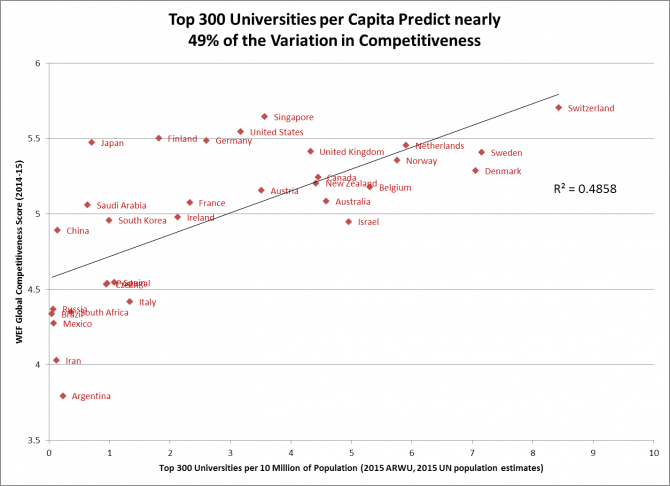With Kirk Heffelmire
I appreciated the opportunity to tell the Mason story in this Washington Post profile appeared in the print section today. As we discuss there, the common characteristic of the most innovative hubs in the world is the presence of one or several world-class research university. That’s why we have as a goal to further develop our research capabilities and to become a catalyzer of the entrepreneurial activity in our region.
As posted here previously, there is a strong relationship between economic competitiveness and a concentration of research-intensive universities.
We have re-run our analysis with the latest available data and the results remain consistent. The chart below shows the countries with universities ranked in the top 300, according the 2015 Academic Ranking of World Universities (George Mason University is ranked in the top 200). This ranking measures the research productivity of universities in terms of articles in top academic journals, citations and prestigious international awards (e.g. the Nobel Prize).
The countries in the chart are plotted against their competitiveness scores from the World Economic Forum.
Almost 49 percent of the variation in competitiveness can be accounted for by the number of top universities per 10 million of population.
The World Economic Forum Global Competitiveness Index is based on 12 pillars that project the productivity level of a country. One of these pillars is Higher Education & Training, which indicates the importance of universities to economic prosperity. However, universities also indirectly support other pillars by conducting research and developing the human talent necessary to thrive in a knowledge economy.
Our research goals are not arbitrary. They are essential for the economic prosperity of our region.
For the last few months, under the leadership of our colleague Steve Fuller and the support of business groups–most notably the 2030 Group–we have engaged in a process to map out a roadmap for the future of our regional economy. As the Washington Post reported this weekend, Dr. Fuller has warned that between 2010 and 2020, the federal share of Greater Washington economy is projected to drop from 40 percent to 29 percent.
What got us here is unlikely to move us forward. A plan B is badly needed. And in the 21th Century, that plan B can only come from knowledge-intensive, research-backed industries.

